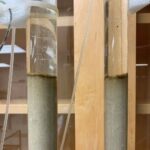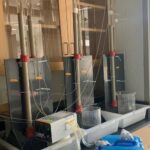Climate change-exacerbated landscape disturbances and pressures are increasingly challenging the water industry globally. Not only do floods, droughts, and wildfires threaten water supply and stormwater management, they can also pose significant challenges to drinking water treatment processes. Drinking water treatment plants are designed for a wide range of source water quality conditions, but as water quality is typically linked to watershed disturbances and shifts, typical design considerations are being pushed beyond their limits after severe disturbances.
Plants that are equipped with conventional drinking water treatment technologies can experience increased costs and supply interruptions as a result of water quality changes after watershed disturbances. Increases in concentration and change in character of natural organic matter (NOM), which is often episodically altered in source water after disturbance in wildland watersheds, can cause increased coagulant demand. Rapid fluctuations in source water NOM can be especially challenging for treatment operations because coagulant doses may need frequent adjustment. Coagulant dosing is time consuming to optimize and changing source water quality conditions may quickly render identified doses sub-optimal. Inadequate coagulation can then have cascading effects on downstream treatment, potentially compromising the provision of adequate amounts of safe drinking water, which can have public health implications if sustained for periods of days or longer. These challenges highlight the urgent need for treatment solutions that are resilient to source water quality changes and operationally appropriate for the communities they serve.


Biofiltration technologies
More and more, nature-based solutions (NBS) are proposed and implemented to respond to climate change threats to the water industry. This is especially evident in management of urban flooding by harnessing the natural infiltration properties of vegetated landscapes (e.g. rain gardens or bioswales). Although less common, similar approaches can be integrated into drinking water treatment.
Biofiltration technologies are a great example of this. They include a range of biologically mediated treatment processes, ranging from slow sand filtration to classical biofiltration in which conventional rapid rate granular media filters are operated without chlorine in the filter influent and sometimes preceded by oxidation to enhance removal. In biofiltration processes, natural microbial communities develop on and within filter media and contribute to treatment by degrading contaminants, including NOM. Because these processes can be relatively passive, some types of biofiltration offer low energy and low maintenance alternatives to some conventional technologies, which can be especially valuable for smaller drinking water treatment plants. Of course, as process performance requires control and monitoring to ensure sufficient treatment, biologically mediated treatment processes are more aptly described as “techno-ecological NBS”.
Biofiltration processes are especially promising to address NOM-related treatment concerns post-watershed disturbance. Conventional treatment technologies rely on coagulation for NOM removal. However, changes in concentration and character of NOM in source water following watershed disturbances can challenge coagulation processes because NOM exerts coagulant demand and can compromise coagulation effectiveness. Although NOM itself is not a health concern nor a regulated contaminant, it can react with disinfection chemicals like chlorine to produce potentially harmful disinfection by-products. NOM in finished water can also create biological instability in the distribution system, providing the nutrients necessary for opportunistic pathogens like Legionella to proliferate. Biofiltration could be a treatment solution to address elevations and shifts in source water NOM post-watershed disturbance, although it has not yet been systematically investigated in this context.
Biofiltration in wildfire-prone regions
After severe wildland fire, vegetation is reduced or absent so that more precipitation reaches the land surface, typically leading to increased erosion and solids runoff. Pyrogenic materials that are episodically delivered to receiving waters can release nutrients such as bioavailable phosphorus and organic carbon to the water column, which can contribute to algae proliferation and NOM transformation in untreated water storage reservoirs and increased coagulant demand in treatment plants. While some watershed regions are not fire-prone, treatment processes resilient to wildfire-associated organic carbon threats are also likely resilient to disturbances that result in similar erosion-associated water quality changes.
To investigate whether biofiltration could offer treatment resilience in wildfire-prone systems, duplicate bench-scale biofilters treating agriculturally and municipally impacted source water (preceded by roughing filtration for solids removal) were intermittently fed wildfire ash-amended water. Their performance was compared to that of control biofilters that continued to treat source water without ash. Interestingly, the wildfire ash did not seem to affect the removal of NOM by the biofilters. NOM is complex, but its fractions added after wildfire ash was mixed with water tended to be smaller and thus more biodegradable, although some smaller amounts of larger, more aromatic substances were also added. The biodegradable fractions were removed by the biofilters, whereas the larger aromatic substances were less well-removed. Since more biodegradable fractions of organic carbon were added by the wildfire ash, this suggests that biofiltration could be a promising drinking water treatment solution for wildfire-impacted source waters. However, the bench-scale results may not be representative of what could be expected at an actual treatment plant, and more work is needed to investigate how bench-scale biofilters scale up to full-scale biofiltration.

Promising, but not perfect
Evidence that biofiltration is resilient to changes in NOM following severe watershed disturbances like wildfires is encouraging, especially since they require less operational demand and resources compared to conventional technologies—which can be beneficial particularly for small systems. However, bench-scale biofilter experiments with wildfire ash showed that NOM character is an important consideration in assessing whether it can be removed effectively by biofiltration. With the wildfire ash and source water used in the experiments, a large fraction of small and biodegradable NOM was added with ash addition, which likely contributed to the effectiveness of biofiltration in removing NOM. However, more aromatic carbon can also be elevated in source waters after wildfire disturbances. Other watershed disturbances like floods can also result in elevated aromatic NOM in source waters. These larger and more aromatic fractions are less biodegradable and thus less effectively removed by biofiltration. Therefore, biofiltration may not always be resilient to changes in NOM after severe watershed disturbances because not all organic carbon is easily biodegradable.
Fortunately, biofiltration technologies come in many different forms, and various pre-treatments can either remove NOM that is more recalcitrant to biodegradation (e.g. with coagulation of aromatic NOM) or increase the biodegradability of NOM prior to its removal by biofiltration (e.g. with ozonation to break down recalcitrant NOM into more biodegradable fractions). These pre-treatment options merit further investigation, though biofiltration remains a promising techno-ecological NBS to address NOM-related treatment concerns due to climate change-exacerbated threats to water quality, especially for systems that can benefit from its low operational demand and energy requirements.
For further reading visit watercanda.net/resources-jf23
Emma A.J. Blackburn is a PhD student in the Department of Civil and Environmental Engineering at the University of Waterloo, where her research is focused on biofiltration technologies for treatment resilience and climate change adaptation.
Monica B. Emelko is a Professor of Civil and Environmental Engineering and Canada Research Chair in Water Science, Technology & Policy at the University of Waterloo, where she also serves as the Associated Director of the Waterloo Climate Institute.









